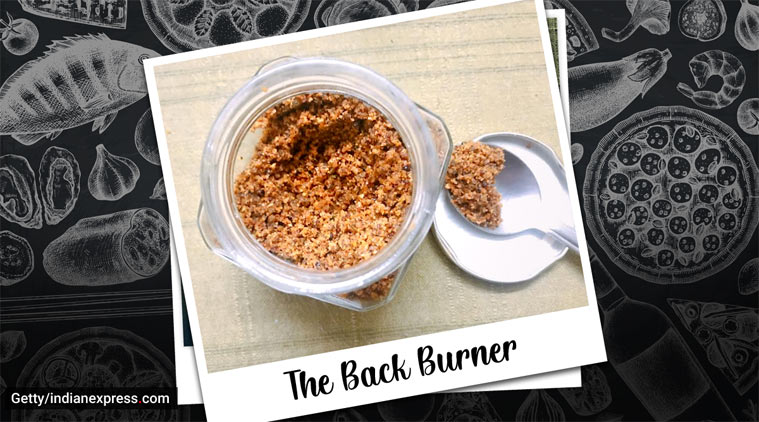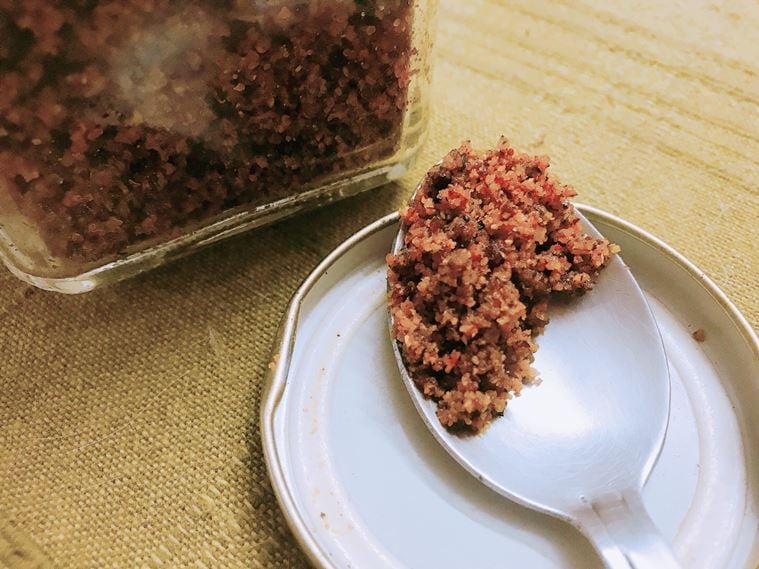 Store the chammanthi podi in an air-tight jar and always use a clean, dry spoon. (Photo: Pooja Pillai)
Store the chammanthi podi in an air-tight jar and always use a clean, dry spoon. (Photo: Pooja Pillai)
It seems that I can’t stop writing about chutney powders. But I have more than one good reason for it. Chutney powders are so easy to make and also so tasty. They’re very versatile too, going well with rice, idlis, dosas and even rotis, sometimes, alongside dal and subzi. And there’s such a variety to choose from; in just a couple of hours, you can, if you choose to, make seven different chutney powders for the seven days of the week.
Today’s recipe is my mother’s version of the very popular chammanthi podi (which is the literal Malayalam translation of ‘chutney powder’). I usually make it when there’s a lot of grated coconut in the fridge, that’s drying out because I was too lazy to use it to make more time-consuming dishes. Which is a fair trade-off, if you ask me, because chammanthi podi is one of my all-time favourite podis. After all, coconut is probably the greatest ingredient on the planet (you can argue with me on this, but you won’t change my mind).
For this podi, grated coconut is roasted to release deep, smoky-sweet flavour notes that are complemented by jaggery’s own particular sweetness. These two different types of sweetness are carefully balanced by the heat of red chillies and the mouth-puckering tang of tamarind.
Most recipes that I’ve seen use these basic ingredients, along with curry leaves, asafoetida and urad dal; some also use shallots or Madras onions, ginger and black peppercorn. Almost none that I’ve read use coriander leaves. This, as far as I know, is my mother’s innovation; a beautiful one, if you ask me, because the coriander’s strong herby taste strengthens the savoury notes of the podi.
Ingredients
1 tsp – Coconut oil
1 cup – Grated fresh coconut
1 tap – Urad dal
Handful of coriander leaves, preferably sun-dried
6-7 – Fresh curry leaves
10-12 – Dried red chillies (you can use more or less, depending on how potent these chillies are)
1 inch – Piece of tamarind
1-2 tsp- Crushed jaggery (adjust this depending, depending on your preference)
½ tsp – asafoetida
Salt, to taste
 The deep, smoky-sweet flavour notes of roasted coconut is what makes this podi so delicious. (Photo: Pooja Pillai)
The deep, smoky-sweet flavour notes of roasted coconut is what makes this podi so delicious. (Photo: Pooja Pillai)
Method:
*Heat coconut oil in a kadhai on medium flame and fry urad dal till it turns golden.
*Reduce flame and add the red chillies, grated coconut, coriander and curry leaves and tamarind and roast till the coconut starts to turn brown and emits its characteristic toasty aroma.
*At this point, add the jaggery and stir to incorporate completely, then quickly add the asafoetida and turn off the heat. Add salt and allow the mixture to cool to room temperature before grinding. Don’t grind for too long, or the coconut will release its oil. Just pulse it a few times till you get a grainy powder.
*Store in an airtight container and use within a couple of weeks. If you’ve not roasted the coconut well, it could go rancid pretty quickly, so you can store the chammanthi podi in the fridge. Just make sure to always, always use a clean and dry spoon when serving yourself some.
The chammanthi podi is usually eaten with rice. But you do you. If you want to sprinkle it on your buttered toast, feel free. This is a judgement-free zone.
[The Back Burner is a biweekly blog that will talk about all things food (with recipes, of course)]